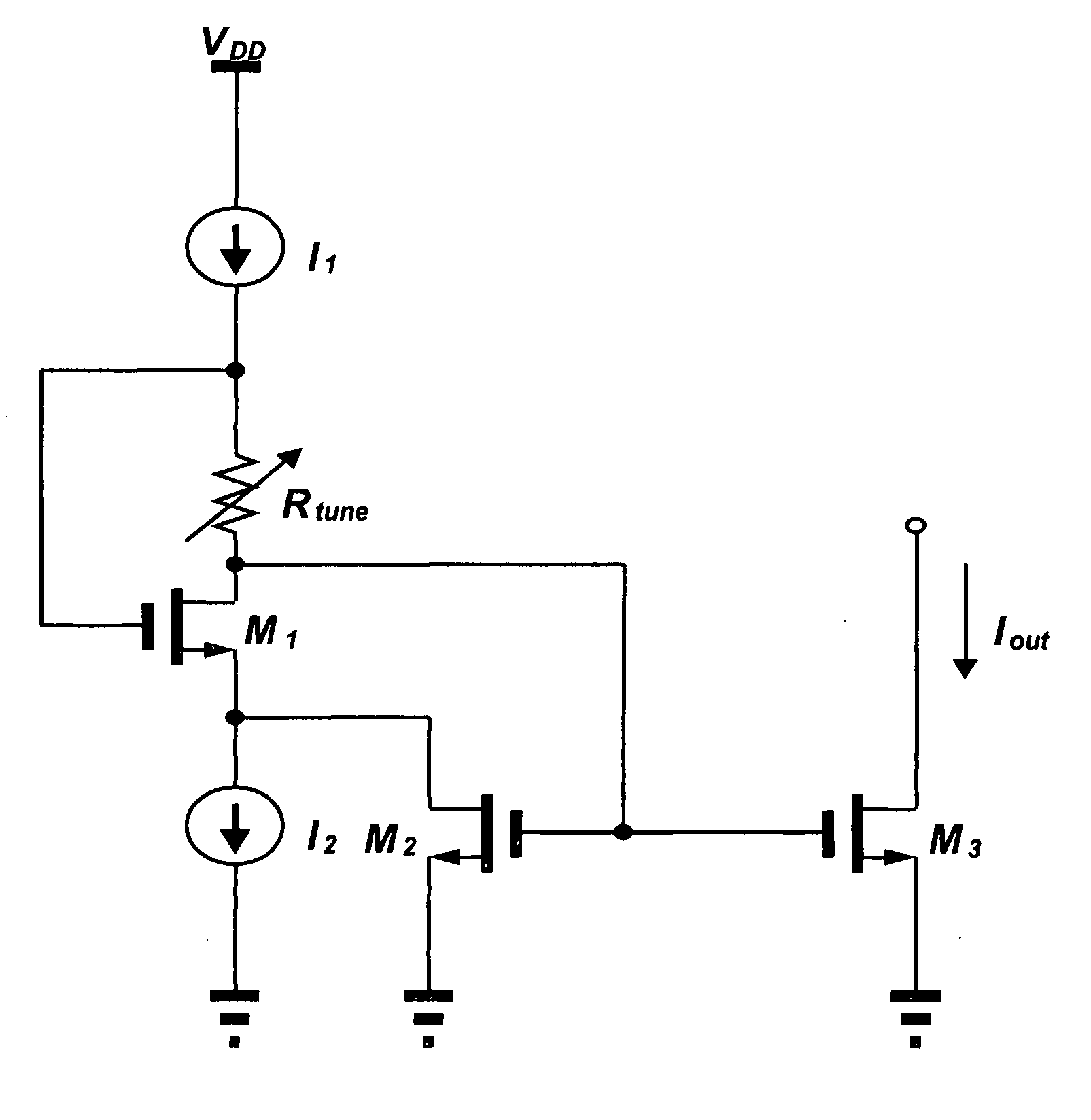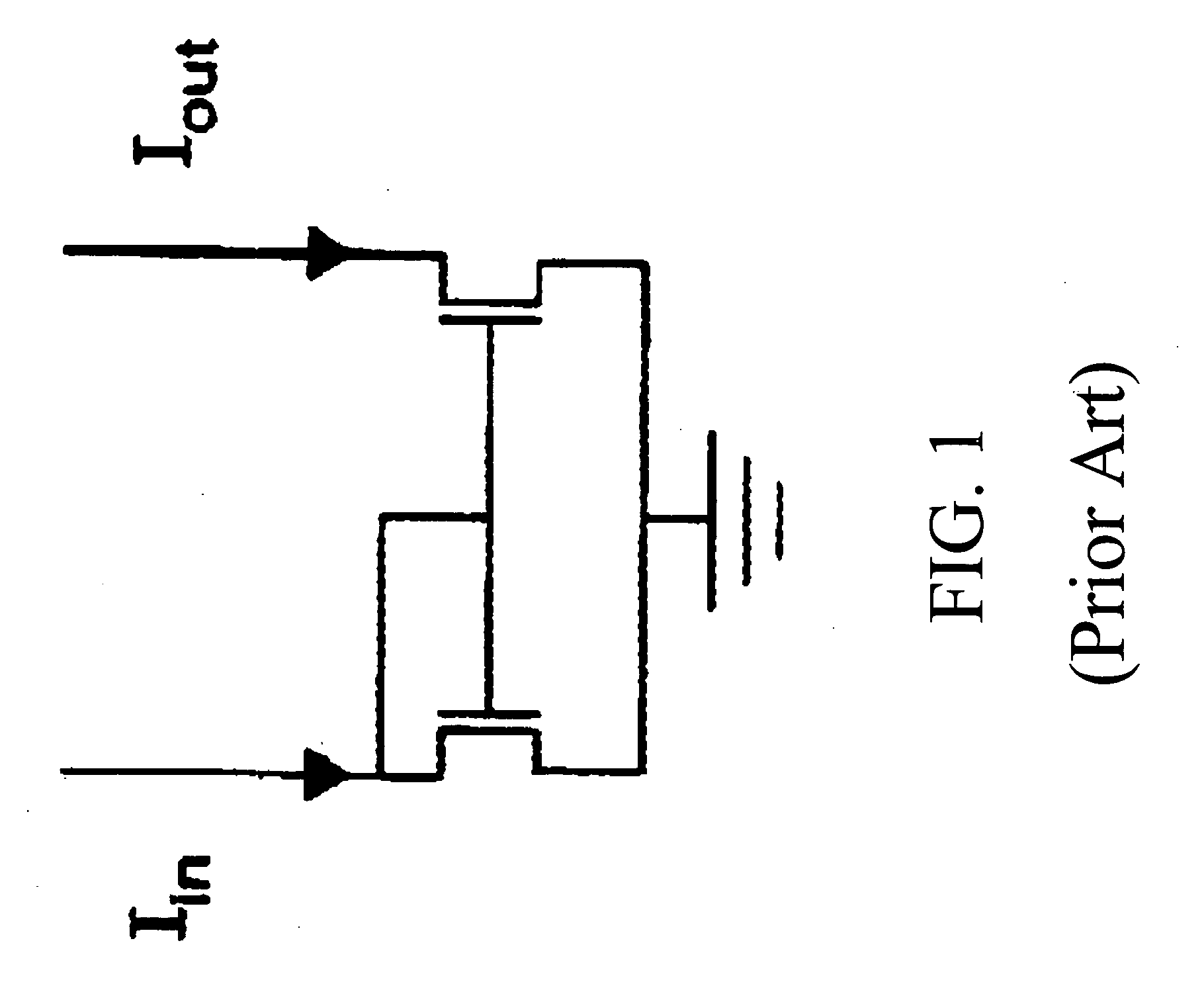Current mirror with low static current and transconductance amplifier thereof
- Summary
- Abstract
- Description
- Claims
- Application Information
AI Technical Summary
Benefits of technology
Problems solved by technology
Method used
Image
Examples
first embodiment
[0025]FIG. 6 shows the current mirror with a low static current according to the invention. The load is a tunable resistor Rtune. The current mirror 30 with a low static current contains a tunable resistor Rtune, a first transistor M1, a second transistor M2, and a third transistor M3.
[0026] The tunable resistor Rtune has a first end and a second end. The first end is coupled to the first input current I1. A fixed voltage difference VDS is supplied between the first and second ends.
[0027] The tunable resistor Rtune can be made of a metal oxide semiconductor (MOS) operating in the semiconductor linear region.
[0028] The drain of the first transistor M1 is coupled to the second end of the tunable resistor Rtune. Its gate is coupled to the first end of the tunable resistor Rtune. Its source is coupled to the second input current I2.
[0029] The drain of the second transistor M2 is coupled to the source of the first transistor M1. Its gate is coupled to the second end of the tunable res...
second embodiment
[0034]FIG. 7 shows the disclosed current mirror with a low static current. In this embodiment, the load is a combination of an amplifier Amp and a fourth transistor M4.
[0035] The current mirror 30 with a low static current includes: a first transistor M1, a second transistor M2, a third transistor M3, a fourth transistor M4, and an amplifier Amp.
[0036] The amplifier Amp includes a positive input end, a negative input end, and an output end.
[0037] The drain of the fourth transistor M4 is coupled to the positive input end of the amplifier Amp. Its gate is coupled to the output end of the amplifier Amp. Its source is coupled to the negative input end of the amplifier Amp.
[0038] The drain of the fourth transistor M4 is a first end of the load. Its source is a second end of the load. When the current passing through the fourth transistor M4 changes, a negative feedback mechanism is formed through the connection of the amplifier Amp, adjusting the voltage drop between the drain and sou...
third embodiment
[0045]FIG. 9 shows a block diagram of the transconductance amplifier in the invention. The transconductance amplifier contains: a voltage amplifier stage 30, a transconductance stage 40, and a current amplifier stage 50.
[0046] The voltage amplifier stage 30 amplifies the voltage. The transconductance stage 40 is coupled to the voltage amplifier stage 30 to convert the voltage into a current. The current amplifier stage 50 is coupled to the transconductance stage to amplify the current. It contains a current mirror with a low static current that is used as a reference buffer at a low voltage or as a current driver.
[0047]FIG. 10 shows the circuit diagram of the transconductance amplifier in the third embodiment. The voltage amplifier stage 30 contains: a first voltage amplifier 10 and a second voltage amplifier 20 coupled with each other.
[0048] The first voltage amplifier 10 contains: a first input differential pair and a first load differential pair. The transistors M2 and M3 form ...
PUM
 Login to View More
Login to View More Abstract
Description
Claims
Application Information
 Login to View More
Login to View More - R&D
- Intellectual Property
- Life Sciences
- Materials
- Tech Scout
- Unparalleled Data Quality
- Higher Quality Content
- 60% Fewer Hallucinations
Browse by: Latest US Patents, China's latest patents, Technical Efficacy Thesaurus, Application Domain, Technology Topic, Popular Technical Reports.
© 2025 PatSnap. All rights reserved.Legal|Privacy policy|Modern Slavery Act Transparency Statement|Sitemap|About US| Contact US: help@patsnap.com



